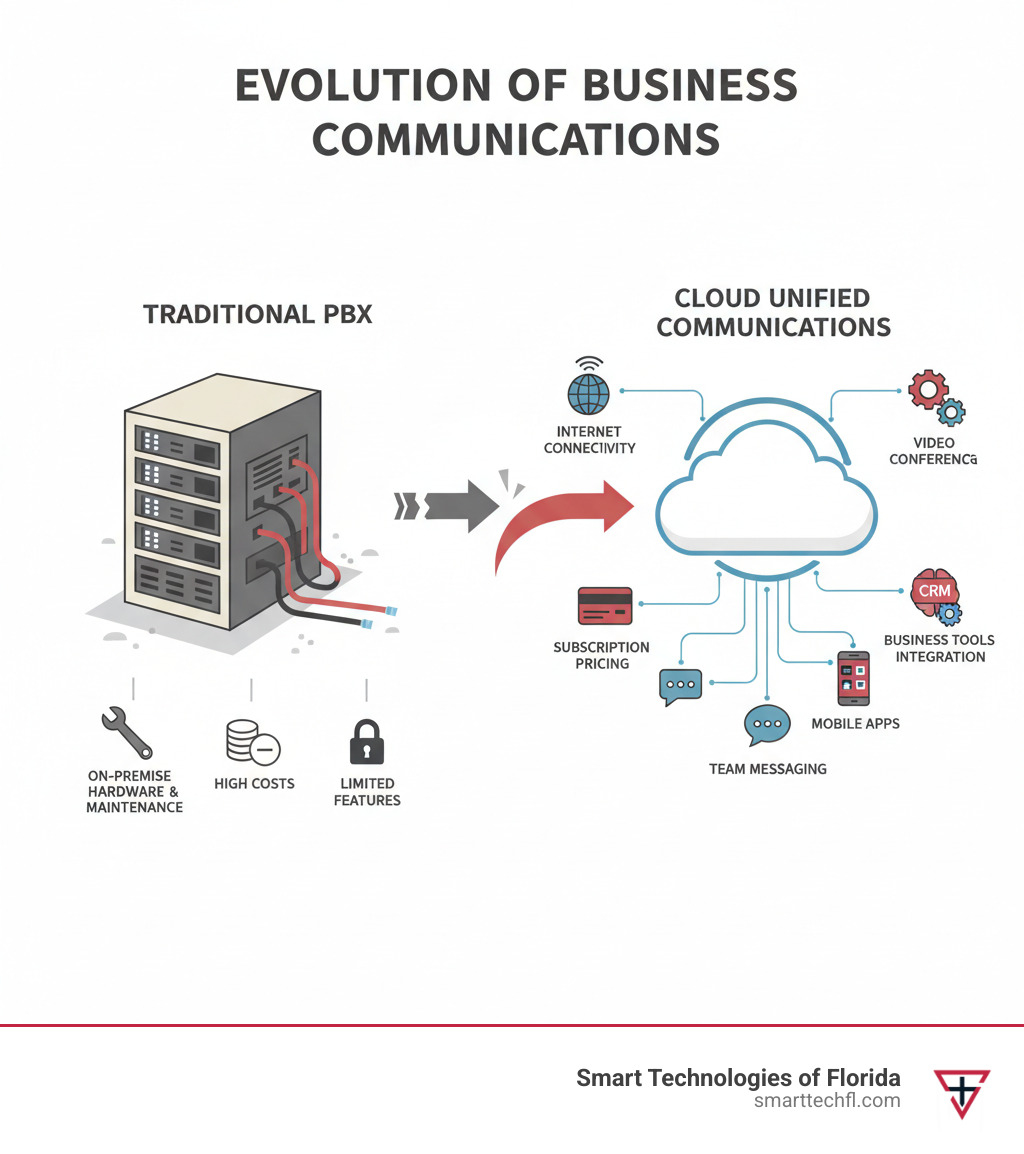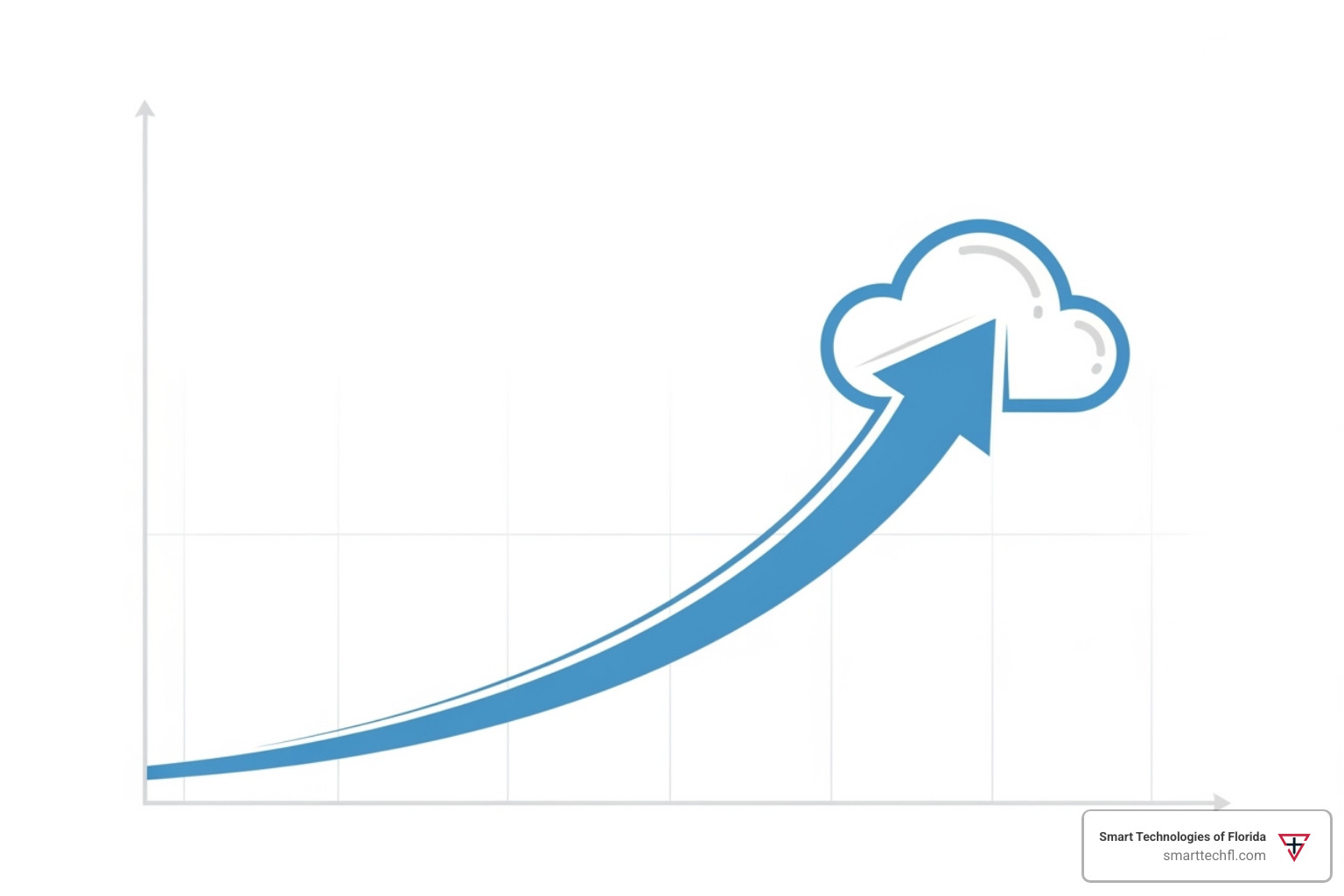Cloud Clarity: Discovering the Best Business Communication Solutions
AI Overview: Why Cloud-Based Business Communications Solutions Are Transforming Modern Business
Cloud-based business communications solutions are redefining how organizations connect, collaborate, and compete. By replacing outdated on-premise phone systems with internet-powered platforms for voice, video, messaging, and collaboration, businesses gain a future-proof, scalable, and cost-efficient way to stay ahead in a fast-moving market.
Why Cloud Based Business Communications Solutions Are Changing Modern Business
Cloud based business communications solutions are essential for modern businesses seeking operational efficiency and a competitive edge. These internet-based platforms replace traditional phone systems with unified tools for voice, video, messaging, and collaboration, accessible from any device, anywhere.
Key Benefits of Cloud Communication Solutions:
- Cost Reduction: Eliminates expensive on-premise hardware and maintenance.
- Scalability: Instantly add or remove users as business needs change.
- Mobility: Enables remote and hybrid work with consistent access across all devices.
- Integration: Connects with business tools like CRM and productivity suites.
- Advanced Features: Provides AI-powered analytics, call recording, and automated workflows.
- Reliability: Offers enterprise-grade uptime and disaster recovery.
The shift to the cloud is about empowering your workforce and streamlining operations. With approximately 94% of companies worldwide now using cloud technology, businesses still relying on traditional systems risk falling behind. Unlike old systems with high upfront investments and limited features, cloud solutions offer a predictable, subscription-based model with continuous updates.
This transition also supports modern work preferences, as 87% of people would choose flexible work arrangements when given the option. Cloud communications provide the seamless connectivity needed to make flexible work a reality, boosting employee satisfaction and productivity.

Cloud based business communications solutions terms to know:
The Core Benefits: Why Businesses are Moving to the Cloud
The modern business world moves fast, and staying competitive requires tools that deliver operational agility and future-proofing capabilities. We’re witnessing a massive shift toward cloud adoption, which has become an essential foundation for modern business operations.
The numbers tell the story: approximately 94% of companies worldwide are now using cloud technology. This reflects a strategic decision to position businesses for long-term success. Cloud based business communications solutions represent a pathway to transform operations by streamlining workflows, fostering collaboration, and adapting quickly to market changes, all while enhancing security and accessibility.

Improved Collaboration and Productivity
When businesses switch to cloud communications, they immediately notice improved collaboration. All communication tools—voice, video, messaging, and file sharing—reside on one centralized platform, eliminating the need to juggle multiple applications. This unified approach enables real-time communication that keeps teams connected and projects on track.
Features like simultaneous document editing and integrated task management create a natural, effortless workflow. The impact on productivity is clear: teams spend less time on “app switching” fatigue and more time on productive work.
The growth numbers reflect this shift. For example, one leading collaboration platform surpassed 300 million users in 2023, while another major provider added six million users in the same year. These statistics show how millions of businesses are using cloud technology to revolutionize internal communication and drive unified communications in business success.
Significant Cost Savings and Scalability
Traditional communication systems involve hefty upfront hardware purchases, ongoing maintenance, and dedicated IT staff—a significant financial burden. Cloud based business communications solutions reimagine this cost structure by eliminating expensive on-premise hardware and reducing operational overhead.
The shift from Capital Expenditure (CapEx) to Operating Expenditure (OpEx) is transformative. Instead of large, unpredictable equipment purchases, you get predictable monthly subscription costs that simplify budgeting. This pay-as-you-go model frees up capital for growth initiatives.
Scalability is where cloud solutions truly shine. Traditional systems require purchasing and installing new hardware to add users. With cloud solutions, scaling up or down is as simple as adjusting your subscription. This flexibility is invaluable for businesses experiencing rapid growth, seasonal fluctuations, or market changes. For a detailed breakdown, explore our guide on cloud voice services cost benefits explained and our cloud telephony pricing guide for businesses.
Empowering Remote and Hybrid Workforces
The requirement for employees to be physically present to communicate effectively is obsolete. Today’s businesses need communication solutions that match the flexibility their teams demand.
Cloud based business communications solutions are the perfect enabler for modern work arrangements. Employees can work from anywhere with a consistent user experience across laptops, tablets, and smartphones, thanks to device flexibility from softphones and mobile apps. Your team accesses the same channels, features, and contacts regardless of location, maintaining productivity and ensuring seamless connectivity.
This flexibility is a powerful competitive advantage. Research from McKinsey shows that when given the option for flexible work, 87% of people would take it. By offering cloud-enabled flexible work, you can tap into a broader talent pool and foster a more satisfied workforce. Most importantly, cloud communications ensure business continuity, allowing operations to continue uninterrupted even when office access is limited. For more insights, check out our guide to business communication solutions that work.
Elevating Customer Service and Engagement
In today’s market, customer experience is a key differentiator. Customers expect swift, personalized, and consistent interactions, which is where cloud based business communications solutions transform service and engagement.
Omnichannel support becomes effortless, allowing customers to reach you via their preferred method—phone, email, chat, or social media—while agents see a unified view of all interactions. With CRM integration, a customer’s complete history appears on your agent’s screen during a call, enabling personalized support that leads to faster response times and higher first-call resolution rates.
Call analytics provide valuable insights into call volumes, agent performance, and customer satisfaction trends, helping you refine your service strategy. The result is personalized experiences that build customer loyalty and drive growth. For specific strategies, explore how to improve retail customer experience.
Understanding the Types of Cloud Based Business Communications Solutions
When exploring cloud based business communications solutions, it’s helpful to understand the available options. The cloud communication landscape offers solutions for every business size and need, broken down into different service models designed to solve specific challenges. Our Cloud Communication Platforms Guide walks you through the options in detail.

Unified Communications as a Service (UCaaS)
Unified Communications as a Service (UCaaS) delivers all your communication tools in one place. It integrates voice calls, video meetings, instant messaging, and collaboration tools into a single, seamless platform. This allows teams to start a chat, escalate to a video call, and share documents in real-time without switching between apps.
This streamlined management approach is gaining rapid adoption. Nearly 30% of organizations have already adopted a UCaaS solution, with another 26% planning to switch soon. Businesses are finding that unified communications is essential for productivity. UCaaS eliminates the complexity of managing separate systems, giving your team powerful tools to collaborate effectively. For a deeper look at how this can transform your operations, explore our insights on Unified Communications Solutions.
Voice over IP (VoIP) and Cloud PBX
Voice over Internet Protocol (VoIP) started the cloud revolution by routing calls over the internet instead of traditional phone lines. It’s the foundation of modern cloud communications.
Building on VoIP, a Cloud PBX acts as a virtual phone system that lives entirely in the cloud, replacing bulky on-premise hardware with software managed by your provider. This gives you sophisticated call features without the headache of maintaining physical equipment.
Advanced call features include intelligent call routing, auto-attendants, voicemail-to-email, call queues, and call forwarding, ensuring you never miss important calls. What makes this so powerful is the scalability and centralized management. Adding new employees requires a few clicks in a web dashboard, not new hardware, making your phone system as flexible as your business. Our page on VoIP explains the technology, and you can learn more in our guide to Business VoIP Providers Benefits.
Key Features to Look For in a cloud based business communications solutions
When evaluating cloud based business communications solutions, the right features can transform your business. Look for capabilities that improve both employee productivity and customer experience.
- Auto-attendant and IVR systems create a professional first impression and direct callers efficiently.
- Call recording is invaluable for training, quality assurance, and compliance.
- Analytics and reporting turn your communication system into a source of business intelligence, revealing patterns in call volumes and customer satisfaction.
- Voicemail transcription saves time by converting voice messages to text for quick review.
- Mobile and desktop apps ensure your team stays connected and productive from anywhere.
- Team messaging facilitates quick internal communication and project coordination.
- Video conferencing supports remote teamwork and client presentations with screen sharing and recording.
- Robust integration capabilities with CRM, productivity suites, and other tools transform your communication platform into a central hub for all business processes.
Choosing Your Solution: A Strategic Guide for Implementation
Choosing and implementing the right cloud based business communications solutions is a critical strategic process. It requires careful needs assessment, thorough vendor evaluation, and meticulous migration planning. With the right roadmap, this journey can be smooth and rewarding. We believe that asking the right questions is your first step toward finding the perfect fit.

Factors to Consider When Selecting a Provider
Choosing the right provider is like selecting a long-term business partner. It’s about more than features or price; it’s about reliability and support.
- Reliability and Uptime: Look for providers with robust uptime guarantees (often 99.999%) and redundant infrastructure to ensure constant connectivity.
- Customer Support: Evaluate support channels, hours, and reputation. A quality managed service provider acts as an extension of your team.
- Pricing Models: Understand the total cost of ownership, including setup fees, calling rates, and contract terms, to prevent surprises.
- Scalability: Ensure you can easily add or remove users as your business changes. This flexibility is a key advantage of the cloud.
- Security and Compliance: Verify the provider adheres to industry standards like ISO 27001, SOC 2, HIPAA, or GDPR, and ask about data encryption and data center security.
- User Experience (UX): Choose a system with an intuitive interface to reduce training time and increase adoption rates.
A Step-by-Step Guide to a Successful Transition
A structured approach ensures a smooth transition to new cloud based business communications solutions with minimal disruption.
- Assess Current Infrastructure: Document your existing systems, network capabilities, and hardware to identify potential challenges.
- Define Business Requirements: Gather input from all departments to determine essential features and solve key pain points.
- Conduct a Pilot Program: Test the system with a small group of users to resolve issues and gather feedback before a full rollout.
- Plan User Training: Develop clear, role-specific training materials to empower your team with the confidence to adopt the new system. Our guide on better onboarding and training plans can help.
- Migrate Data: Work with your provider to securely and seamlessly transfer existing contacts, call logs, and voicemails.
- Establish Post-Launch Support: Create a plan for ongoing questions, monitor system performance, and gather user feedback for continuous improvement.
Critical Security Measures for your cloud based business communications solutions
Protecting sensitive business and customer data is fundamental. Prioritize these security measures when moving your communications to the cloud.
- Data Encryption: Ensure data is encrypted both in-transit (moving across networks) and at-rest (stored on servers) to make it unreadable to unauthorized parties.
- Compliance: Verify your provider meets industry-specific requirements like HIPAA for healthcare or GDPR for handling European data.
- Multi-Factor Authentication (MFA): Implement MFA to add a crucial layer of protection beyond passwords, dramatically reducing unauthorized access risks.
- Secure Data Centers: Confirm the provider uses facilities with robust physical security, environmental controls, and redundant power, often monitored by a 24/7 Security Operations Center.
- Regular Audits and Updates: Your provider should conduct regular security audits and apply updates promptly to protect against evolving threats. For comprehensive protection, consider managed cybersecurity services.
The Power of Integration with Your Existing Systems
Integration is what makes cloud based business communications solutions truly transformative, creating efficient workflows and unified operations.
- CRM Integration: Instantly display a customer’s complete history during a call, enabling personalized support and faster resolutions.
- Helpdesk Platform Integration: Log and manage every customer interaction in your existing support system, ensuring nothing falls through the cracks.
- Productivity Suite Integration: Streamline collaboration by launching calls or sharing documents directly from tools like Microsoft 365 or Google Workspace.
- Open APIs: Use Application Programming Interfaces for custom integrations with specialized internal or industry-specific software.
- Workflow Automation: Automate tasks like creating follow-ups for missed calls or updating CRM records after an interaction. This is business process automation at its finest.
The Future of Business Communication and Real-World Impact
The world of cloud based business communications solutions is constantly evolving with innovations that make communication smarter and more intuitive. We are seeing science fiction become reality, one feature at a time. To understand the bigger picture, see our thoughts on Technology and Business Communication.

The Rise of AI and Automation
AI in cloud based business communications solutions isn’t about replacing humans; it’s about augmenting their capabilities.
- AI-Powered Analytics: Sophisticated analytics help businesses understand communication patterns, predict customer sentiment, and identify which sales approaches are most effective.
- Real-Time Transcription and Summaries: Instantly get clean transcripts and summaries of meetings, complete with action items, eliminating the need for manual note-taking.
- Sentiment Analysis: This technology reads the emotional tone of conversations in real-time, allowing agents to adjust their approach and de-escalate frustrated customers.
- Automated Workflows: Systems can automatically handle routine tasks like scheduling follow-up calls or sending personalized emails, freeing up humans to focus on relationship-building.
- Virtual Assistants: AI-powered assistants can handle complex customer inquiries, book appointments, and process transactions 24/7. For a deeper dive, check out our guide on AI Automation Tools.
Real-World Success Stories and Use Cases
Thoughtfully implemented cloud based business communications solutions are delivering incredible results across various industries.
- Healthcare: Telemedicine is revolutionizing patient care, allowing doctors to connect patients with remote specialists via secure video conferencing. Care teams collaborate seamlessly using encrypted messaging and secure file sharing.
- Retail: Businesses are creating omnichannel experiences where a customer’s journey is tracked across chat, phone, and email. Agents always have the full context, so customers never have to repeat themselves.
- Financial Services: Advisory firms use cloud communications with high-level encryption to conduct secure video meetings and share confidential documents, maintaining security while offering modern convenience.
- Professional Services: Consulting firms and law practices use UCaaS platforms to foster collaboration among geographically scattered teams. Real-time document sharing and video check-ins create a strong company culture and ensure efficient project delivery.
These examples show how the right communication strategy can solve real business challenges, improving experiences for both employees and customers. It’s all part of the Business Change Process, and it’s happening now in every industry.
Frequently Asked Questions about Cloud Communication
We know that diving into cloud based business communications solutions can bring up a few questions. That’s totally normal! We’re here to clear things up and make sure you feel confident about making the best choices for your business. Here are some of the most common questions we hear:
What is the main difference between cloud communications and traditional phone systems?
Think of it this way: traditional phone systems, often called PBX systems, relied on physical boxes and wires right there in your office. You had to buy all that hardware, install it, and then maintain it yourself. It was a big upfront investment, and adding new features or lines could be a real headache!
Cloud based business communications solutions, on the other hand, are hosted entirely by your service provider and delivered right to you over the internet. There's no bulky hardware on your premises. This means you get incredible flexibility, allowing your team to connect from anywhere, and amazing scalability, so you can easily add or remove users as your business grows or changes. Plus, you get access to all sorts of advanced features that traditional systems just can't offer, all without the hassle of managing the equipment. It's truly a game-changer!
Are cloud-based communication solutions secure?
This is a fantastic question, and the answer is a resounding yes – when you choose a reputable provider! We understand that safeguarding your business's sensitive data is absolutely critical. Top-tier providers of cloud based business communications solutions make security their highest priority.
They implement robust measures like end-to-end encryption, which scrambles your data to make it unreadable to anyone but the intended recipient. Your information is stored in secure data centers with advanced physical and digital protections, often monitored 24/7. These providers also undergo regular security audits and ensure compliance with important standards like SOC 2, HIPAA (for healthcare organizations), and GDPR (for businesses dealing with European data). On your end, you can boost security even further by implementing policies like multi-factor authentication (MFA) for all users. It's all about layers of protection!
How much do cloud communication solutions typically cost?
The cost of cloud based business communications solutions can vary quite a bit, depending on the provider, the specific features you need, and the number of users. However, one of the biggest advantages is the predictable pricing model! Most solutions are offered on a per-user, per-month subscription basis.
This means you pay a consistent fee each month, making your expenses much easier to budget for. It turns what used to be a large capital expenditure (CapEx) – those big upfront costs for hardware – into a more manageable operating expenditure (OpEx). For many businesses, this translates into significant savings compared to the high initial investment and ongoing maintenance costs of old-fashioned phone systems. Plus, that pay-as-you-go model makes it incredibly scalable, so you only pay for what you actually use.
Conclusion
This is not just a technology upgrade, but a fundamental change in how your business connects, collaborates, and competes. The benefits—from significant cost reductions and unlimited scalability to empowering remote workforces and elevating customer experiences—create organizations that are more agile, efficient, and future-proof.
This is a strategic business decision that positions your organization at the forefront of modern practices. By embracing cloud communications, you choose flexibility over rigidity and innovation over stagnation.
These solutions empower your people to work confidently from anywhere and collaborate seamlessly, while your processes become streamlined and your costs predictable. At Smart Technologies of Florida, we’ve spent 23 years watching businesses transform. Our people-centric approach means we craft digital solutions that align with your unique goals and culture, ensuring every technological step forward empowers your team and delights your customers.
The future of business communication is here. Whether you’re a small business looking to modernize or an established organization ready for the next step, cloud communications offer a practical path to success.
Ready to find how cloud based business communications solutions can transform your organization? Transform your organization with expert guidance on business communication solutions and let’s start this exciting journey together.












